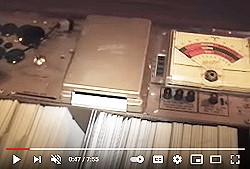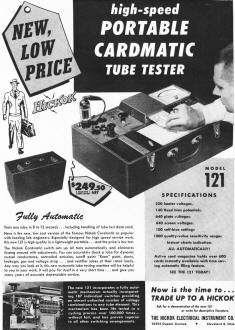Hickok High-Speed Portable Cardmatic Tube Tester |
||
RF Cafe visitor Vincent Sullivan saw the "Barney Turns Inventor" episode of "Mac's Radio Service Shop" series recently posted here which told of Barney's idea for a vacuum tube tester that would set all the switches and voltages based on a coded card for the particular tube type. That story appeared in a 1950 issue of Radio & Television News magazine. I don't know when Hickok came out with their first "Cardmatic" tube tester, but as Vince noted in his message to me, the idea might have been borne of John Frye's fictional scenario. This full-page advertisement for the Hickok Model 121 High-Speed Portable Cardmatic Tube Tester comes from the March 1958 issue of Radio & TV News. A YouTube video of a Model 121 Cardmatic is included below. Said Vincent, "I headed up an electronics lab for theCanadian National Research Council [in the 1980s] which designed and built custom electronic equipment for the support of scientific research at the Herzberg Institute of Astrophysics in Ottawa Canada. We had two of these Cardmatic testers which I used extensively. If memory serves me correctly they were the Model 123 version." Further, "In the Hickok version the cards were a plastic sheet full of holes which you slid into a holder with your right hand while holding down a large palm operated spring loaded plunger with your left hand. Releasing the plunger engaged the mechanism that sensed the holes in the card and programmed the tester (For some reason the palm operated plunger always made me think of the emergency SCRAM control on a nuclear reactor)...<see more at bottom> Hickok High-Speed Portable Cardmatic Tube Tester Ad New, Low Price Hickok $249.50 Net (Includes 300 cards) Model 121 Specifications 320 heater voltages. 140 fixed bias potentials. 640 plate voltages. 640 screen voltages. 100 self-bias settings 1000 quality-value sensitivity ranges. Instant shorts indication. All Automatically! Active card magazine holds over 600 cards instantly available with time saving automatic filing feature. See the 121 Today! Tests any tube in 8 to 12 seconds ... including handling of tube test data card. Here is the new, low cost version of the famous Hickok Cardmatic so popular with leading lab engineers. Especially designed for high speed service work, this new 121 is high quality in a lightweight portable ... and the price is low too. The Hickok Cardmatic switch sets up all tests automatically and eliminates fussing around with adjustments. You can accurately check a tube for dynamic mutual conductance, controlled emission, cutoff point "Knee" point, shorts, leakage, gas and voltage drop ... and rectifier tubes at their rated loads. Any way you look at it, this new automatic tube testing machine will be helpful to you in your work. It will pay for itself in a very short time ... and give you many years of accurate dependable service. The new 121 incorporates a fully automatic mechanism actually incorporating 187 individual switches providing an almost unlimited number of voltage combinations to any tube element. This mechanism has been life tested in a cycling process over 100,000 times - without fail, and has proven superior to all other switching arrangements. Now is the time to ... Trade up to a Hickok Ask for a demonstration of the new 121 or write for descriptive literature. The Hickok Electrical Instrument Co. 10524 Dupont Avenue • Cleveland 8, Ohio
More from Vincent: "Thinking about tube testers has stirred some old memories. My first gig after graduating from Ryerson U. in Toronto in 1975 was to keep all of the communications equipment (VHF & UHF transmitters, receivers, communication control systems, radio positions, etc.) operating properly at Toronto International Airport. All of the TX and RX used vacuum tubes and were much older than I was! It never struck me as odd at the time, but we did not have tube testers. If you suspected a tube was bad you tried a substitution and having a very limited set of types of equipment this was a practical approach. There was an aspect of this that always struck me as ironic. In Canada at the time civilian controllers frequently communicated with military aircraft. To facilitate this we "paired" VHF (civil) and UHF (military) frequencies so that when the controller keyed the TX he went out on 2 frequencies and the received audio from 2 receivers was mixed and sent to the radio position. The UHF equipment was R361 receivers and T282 transmitters which were owned by the US military, loaned to the Canadian Military, who then loaned to us for use. Towards the end of my time at this job (1980) I noticed that the tubes we were receiving as spare parts were arriving in plain white boxes with Cyrillic writing on them and a rubber stamp with the north American tube type designation. Since North American manufacturers were shutting down tube production due to dwindling sales the Canadian Government procurement agents were purchasing vacuum tube from Russia! So here I was, during the cold war, using Russian vacuum tubes to repair U.S. Military receivers and transmitters! "
Posted January 27, 2021 |
||


